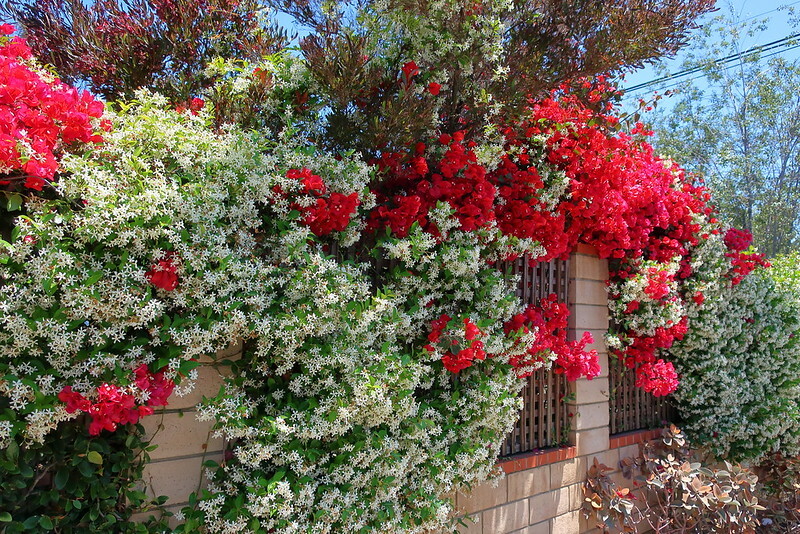Jasmine vines are wonderful for adding both a vertical element and scent to the garden. Jasmine starts blooming in late winter or late spring depending on the type. True Jasmine, scientifically named Jasminum officinale, is only fully winter hardy in USDA growing zones 7-12 and blooms for many months between late spring and mid-summer.
Other vines commonly referred to as Jasmine include Star Jasmine, Asiatic Jasmine, and Arabian Jasmine, which also have twining vines but can tolerate high heat and humidity better than the true Jasmine. Winter Jasmine, Jasminum nudiflorum, is cold tolerant to zone 6 and grows as a shrubby vine.
Use Jasmine to clothe an arbor or trellis and add a vertical element to the garden. It can also be grown as an effective ground cover to suppress weeds and retain soil on moderately sloped sites. More stout types such as Star Jasmine can be sheared back annually to maintain a compact shrub shape in a formal garden area or foundation planting. True Jasmine also tolerates heavy pruning annually to clean up any vines showing signs of winter damage.

Photo by K M, unmodified, Flickr, copyright CC BY 2.0 DEED
Well-draining soil is imperative to the survival of Jasmine during wet and cold winters; however these plants are not picky about soil pH or composition. Jasmine blooms well with at least 6 hours of direct sunlight. Top-dress the soil annually with a granular slow-release fertilizer early in the spring as new growth is emerging.
Shrubs To Plant With Jasmine
Jasmine is a great vine to pair with broadleaf evergreens like photinia, bamboo, and in warmer climates, gardenia. Allowing the more delicate Jasmine vines to twine and travel amongst evergreens can help soften hard lines of clipped hedges while providing an incredible scent in the garden. Star Jasmine is better grown in a shrub form alongside broadleaf evergreens, although it also can be incorporated in a mixed flowering hedge with lilac, shrub rose, forsythia, and hardy citrus shrubs (trees) in warm growing climates.

Photo by K M, unmodified, Flickr, copyright CC BY 2.0 DEED
Perennials To Plant With Jasmine
Jasmine grows well in a Mediterranean-type garden and can offer another level of foliage when planted on supports near lavender, sage, rosemary, and alliums. Several other vining plants grow well with Jasmine including akebia, clematis, and passion vines. Grow several of these vines on a trellis for a stunning long-blooming display throughout the summer months.
Annuals To Plant With Jasmine
Tropical plants often used as late summer annuals make great companions for all types of Jasmine. Fantastic options include Lantana, Tibouchina, Cordyline, and Bougainvillea, which have strongly colored flowers or foliage that makes an interesting contrast to the sedate greens and white of true Jasmine or Star Jasmine. Gardeners can also overwinter these tropical plants indoors as an added bonus. They require a bright location that remains well above freezing all winter.

Photo by K M, unmodified, Flickr, copyright CC BY 2.0 DEED
Best Companion Plants For Jasmine in Containers
The smaller-growing true Jasmine and Arabian Jasmine are particularly suited to containers and make a lovely focal point when grown up a central trellis or other decorative support. Add shallow-rooted annuals or perennials to fill in around the base of the Jasmine. Full sun lovers like Petunias, Calibrachoa, fan flowers, and verbena are great spiller plants and need little pruning through the season. For fillers, consider Pentas, Coreopsis, Salvia, and Geraniums, which can double as spillers as they grow in size.
For a partially shaded site, combine Jasmine with foliage plants, such as hostas, ferns, and hellebores. Ensure the planter has excellent drainage and is watered regularly.
Plants Not To Grow With Jasmine
Star Jasmine and Asiatic Star Jasmine can be aggressive growers if not pruned regularly. Do not plant them in locations with slower-growing shrubs and perennials, which can be easily overwhelmed and possibly pushed out of a garden bed. Astilbe, some varieties of daylily, and low-growing, clumping ornamental grasses are easily dwarfed by the more aggressive vines.
Best Plants To Grow With Jasmine
The best plants to grow with Jasmine are other fast-growing vines such as Clematis, Akebia, and Passion Flower. In cold climates, try growing true and Asiatic Jasmines in containers that can be brought indoors when the weather turns chilly. Arabian and Star Jasmines pruned as shrubs make a lovely evergreen backdrop for other flowering shrubs and perennials.
Sources:
“Jasmine.” Chicago Botanic Garden. chicagobotanic.org
“Jasminum (Jasmine).” North Carolina Extension Gardener Plant Toolbox. plants.ces.ncsu.edu
“Asiatic Jasmine.” Gardening Solutions - University of Florida's Institute of Food and Agricultural Sciences. gardeningsolutions.ifas.ufl.edu
